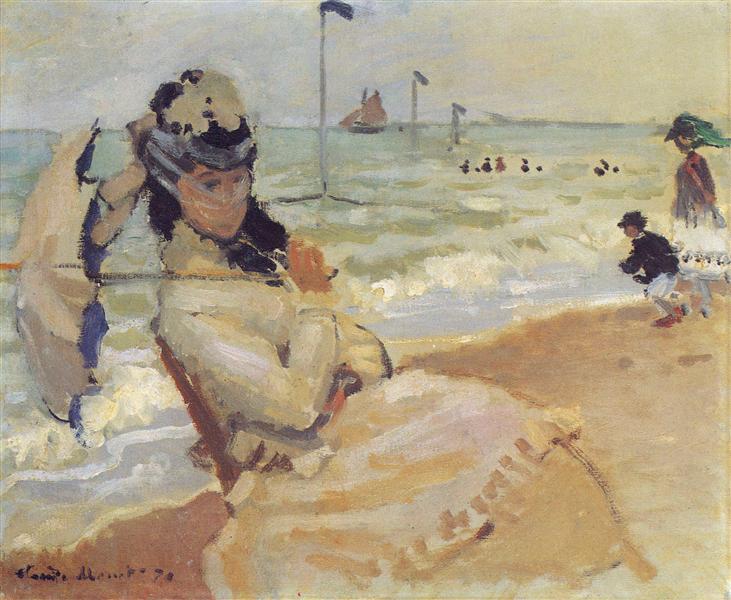Description
The work "Camille on the beach of Truville" (1870) by Claude Monet is a splendid example of the evolution of impressionism, which captures not only a moment and a place, but also an atmosphere of intimacy and lyricism. In this painting, Monet portrays his wife, Camille Doncieux, on one of the most popular beaches in France at that time, which underlines the personal connection that the painter had with his subject. In the painting, Camille is in profile, dressed in an elegant and light beach costume, which resonates with the fashion of the time, balancing an aesthetic of sophistication and simplicity. His figure, rested on the sand, melts with the natural environment, because Monet uses a palette that stands out for its freshness and luminosity.
The composition of the work shows Camille as the central approach, while the coastal landscape extends around it, covering the light blue sea and the sky that unfolds with soft tones. The vibrant tones of the blue and green are intertwined with loose brushstrokes, characteristics of the monet style that seek to capture the essence of light and movement. This technique not only gives life to the scene, but also reflects the constant change of air and the sea, concepts that fascinated Monet.
Monet uses a dynamic light treatment that is reflected in the water, creating a contrast between the figure of Camille and its surroundings. The waves of the sea are represented with slight touches of white and blue, which suggests movement, while the sand is portrayed in warm tones that provide a base for the model figure. The relationship between Camille and nature is palpable; His relaxed possession and the subtle details of his wardrobe evoke the way in which fashion and landscape are intertwined in the experience of coastal life.
Often, Monet's works reveal a deep approach to human relationships and their surroundings, and "camille on Trouville beach" is no exception. Through his wife, Monet not only captures an intimate portrait, but also inserts his personal life within a broader frame that reflects the search for happiness and tranquility that characterized the modern life of the time. This autobiographical element in the work invites the viewer to connect the feelings of nostalgia and joy that arise from one day on the beach, imbued with the ephemeral beauty of the moments of everyday life.
The impressionist style that Monet uses is inserted into a movement that sought to break with the academic conventions of painting, exploring light and color as forms of expression about meticulous detail and strict realism. "Camille on Truville Beach" exemplifies how crucial was this work to motivate interest in landscape catches and appears in a format that resembles a sensory perception more than to an exact reproduction of reality. Through this painting, Monet not only establishes a precedent for future pictorial explorations, but also creates a timeless symbol of love and the connection between man and nature.
This work can be considered as a decisive moment in Monet's career, marking the transition to the splendor of his mature art that would later develop in his famous landscapes of Giverny. In sum, "camille on Truville Beach" is not only a beautiful personal portrait, but it is also a visual expression of the spirit of an era, encapsulating both Monet's personal intimacy and his mastery in the capture of light and the Atmosphere of its surroundings.
KUADROS ©, a famous paint on your wall.
Hand-made oil painting reproductions, with the quality of professional artists and the distinctive seal of KUADROS ©.
Reproduction service paintings With a guarantee of satisfaction. If you are not completely satisfied with the replica of your painting, we refund your money 100%.

